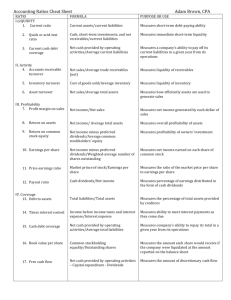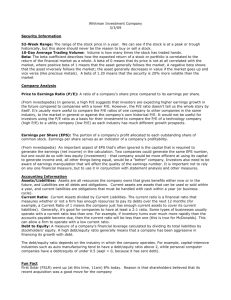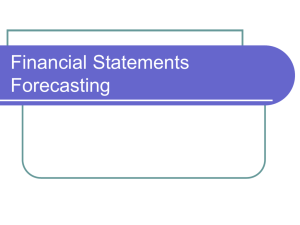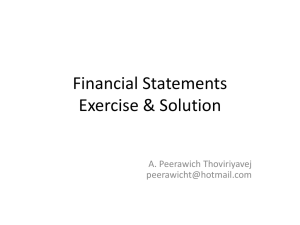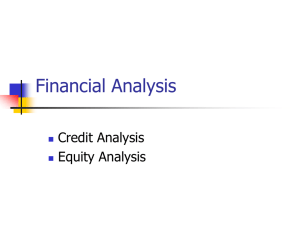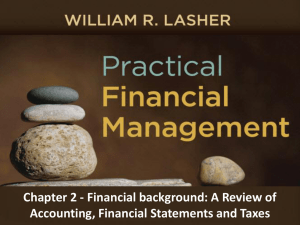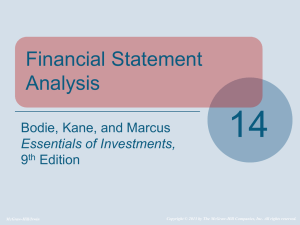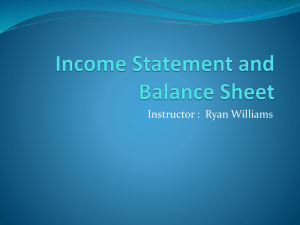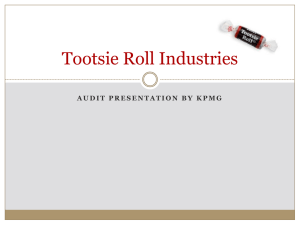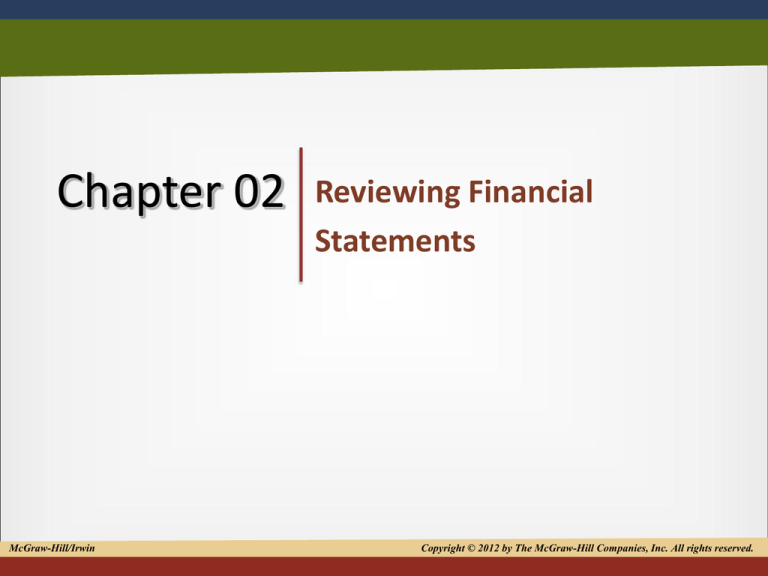
Chapter 02
McGraw-Hill/Irwin
Reviewing Financial
Statements
Copyright © 2012 by The McGraw-Hill Companies, Inc. All rights reserved.
1
Introduction
• Annual report = four basic financial
statements
– balance sheet
– income statement
– statement of cash flows
– statement of retained earnings
• Financial statement is accounting-based
picture of financial position
2-2
Introduction (cont.)
• Accountants: use reports for a picture of past
financial performance
• Finance professionals: use financial
statements to draw future inferences
2-3
Balance Sheet
• Reports firm’s assets, liabilities and equity at a
point in time
Assets = Liabilities + Equity
• Assets of firm, in order of liquidity – left side
• Liabilities, in order of maturity – right side
– Equity listed last – never matures
2-4
In order of liquidity
In order of maturity
2-5
Assets
• Current Assets
– Normally convert into cash within a year
• Cash (and marketable securities)
• Accounts receivable
• Inventory
• Fixed Assets
– Useful life exceeding one year
• Physical (tangible) assets (e.g. net plant and equipment)
• Less tangible, long-term assets (e.g. patents and trademarks)
2-6
Liabilities
• Liabilities are loans to the firm
– Current liabilities
• Obligations due within a year
– Accruals (accrued wages and accrued taxes)
– Accounts payable
– Notes payable
– Long-term debt
• Long-term loans and bonds – maturities > one year
2-7
Equity
• Difference between firm’s total assets and
total liabilities
• Types of Equity
– Preferred Stock
• Hybrid security – characteristics of both long-term debt and
common stock
– Common Stock and Paid-in-Surplus
• Fundamental ownership claim in public or private company
– Retained Earnings
• Cumulative earnings – reinvested – not paid as dividends
2-8
Managing the Balance Sheet
•
•
•
•
Fixed asset depreciation accounting method
Level of net working capital
Firm’s liquidity position
Method for financing firm’s assets
– equity or debt
• Difference between firm’s book value and true
market value
2-9
Fixed Asset Depreciation
Accounting Method
• Reporting purposes
– firms often use straight-line method of
depreciation
• Tax purposes
– firms often use accelerated depreciation such as
MACRS
• higher depreciation expenses, lower taxable income results in
lower taxes in early years of project’s life
2-10
Net Working Capital
Net Working Capital = Current assets - Current liabilities
• Net working capital is measure of firm’s ability to
pay obligations
• Healthy firms have positive net working capital
2-11
Liquidity
• Ability to convert assets into cash at Fair
Market Value (FMV)
• Current assets -- most liquid
– Cash, marketable securities, accounts receivable,
and inventory
– Inventory is least liquid of current assets
• Fixed assets -- less liquid
2-12
Liquidity (cont.)
• Liquidity is double-edged sword -- risk-return
trade-off
– More liquidity
• firm can more easily pay obligations – less risky
– Liquid assets offer low returns
• Cash = zero return
– Fixed assets illiquid
• Help generate revenue and profits
2-13
Debt vs. Equity Financing
• Financial Leverage = debt securities
– Magnifies gains and losses
– Debt holders -- fixed claim on firm’s cash flows
(interest paid on securities)
– Stockholders -- claim on remaining cash flow
• Choice of firm’s capital structure represents
management’s risk and return preference
2-14
Book Value vs. Market Value
• Book Value (historical cost)
– Assets listed on balance sheet at purchase price
• Market value
– Assets listed at value if sold in today’s market
2-15
Income Statement
• Firm’s total earned revenues and total
incurred expenses – over period of time
– Income statement top line = revenues
– Expenses listed below revenues
– Bottom line = difference between revenues and expenses
• Firm’s operating income reported in top part
• Summary of financial and tax structure in
bottom part
2-16
Figure 2.2
The Basic Income Statement
Top Line -- Revenues
Expenses
Bottom Line – difference between
revenues and expenses
2-17
Operating
Income
Fin’l & Tax
Structure
Bottom line
Income/Firm
Value
Summary
2-18
Income/Firm Value Summary Below the
Bottom Line
2-19
Income/Firm Value Summary Below the
Bottom Line (cont.)
2-20
Corporate Income Taxes
• Firms taxed on earnings
• U.S. tax code determines corporate tax
obligations – overseen by Congress
– Tax rate changes driven by changes in
government, business or public environment
– U.S. has progressive tax structure
• the larger the income, the higher the taxes assessed
2-21
2-22
Corporate Income Taxes (cont.)
• Average tax rate
– Percentage of each dollar of taxable income that
the firm pays in taxes
• Marginal tax rate
– Taxes paid for each dollar of firm’s additional
taxable income
2-23
Interest and Dividends
Received by Corporations
• Interest taxable with two exceptions:
– State and local government bonds are federally
tax-exempt
– One corporation owning stock in another
corporation
• 70% of dividends from other corporation are tax exempt.
• Only taxed on remaining 30% at receiving corporation’s tax rate
2-24
Interest and Dividends
Paid by the Corporation
• Interest payments deducted from income before
calculating taxable income on the income statement
• Dividends paid to shareholders not tax deductible
• Due to tax deductibility of interest – debt less
expensive form of financing than equity
2-25
Statement of Cash Flows
• Financial statement that shows firm’s cash flows over
given period of time
– includes only inflows and outflows of cash and marketable
securities
– excludes transactions with no direct effect on cash receipts
and payments
• Statement of Cash Flow bottom line
– Reflects difference between cash sources and uses
– Equals the change in cash on the firm’s balance sheet
2-26
Sources and Uses of Cash
• Cash sources involve:
– Increasing liabilities (or equity)
– Decreasing noncash assets
• Cash uses involve:
– Decreasing liabilities (or equity)
– Increasing non cash assets
2-27
Sources and Uses of Cash
• Cash flow statement reports reflect:
– Operating
– Investing
– Financing activities
2-28
2-29
Cash Flows from Operating Activities
• Represents items directly associated with
producing and selling the firm’s products
– Net income
– Depreciation
– Working capital accounts other than cash and shortterm debt
2-30
Cash Flows from Investing Activities
• Represents cash flows associated with buying
or selling fixed or other long-term assets
• Reflects the firm’s investment in fixed assets
2-31
Cash Flows from Financing Activities
• Cash flows from debt and equity financing
transactions
– Issuing short- or long-term debt
– Issuing stock
– Using cash to pay dividends
– Using cash to pay off debt
– Using cash to buy back stock
2-32
Net Change in Cash
and Marketable Securities
• The bottom line of the statement of cash flows
– total of cash flows from operating, investing, and financing
activities
• Reconciles to the net change in cash and
marketable securities on the balance sheet over the
period
2-33
Free Cash Flow
• The cash available for distribution to the
investors after investments for firm’s
necessary, ongoing operations
2-34
Free Cash Flow (cont.)
• Operating Cash Flow (OCF)
– Firms generate operating cash flow from
operations after they have paid necessary taxes
• Investment in Operating Capital (IOC)
– Purchase of physical capital or funds earmarked to
replace equipment
– Includes fixed assets, current assets, and
spontaneous current liabilities (i.e. accounts
payable and accruals)
2-35
Free Cash Flow (cont.)
• Firms with positive Free Cash Flow (FCF) have
funds available for distribution to investors
• Potential negative FCF implications for firms
– May be experiencing operating or managerial
problems
– May be investing heavily in operating capital to
support growth
• Note: FCF might be negative while OCF is positive
2-36
Statement of Retained Earnings
• Details changes in retained earnings during
reporting period
• Reconciles net income and dividends paid
with changes in retained earnings from one
period to the next
beginning retained earnings
+ net income for period
- cash dividends paid
Ending retained earnings
2-37
Cautions in Interpreting
Financial Statements
• GAAP standards required for financial statements
• Firms can use “earnings management” with GAAP
accounting rules
– “Smooth” earnings
– Use different depreciation methods
• Sarbanes-Oxley Act passed in 2002
– Prevents deceptive accounting and management practices
2-38


